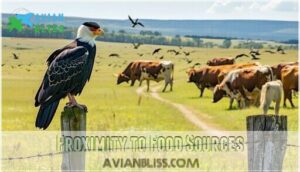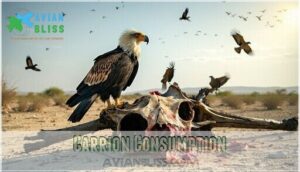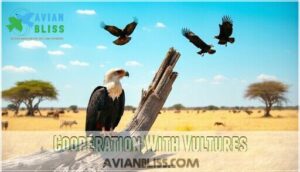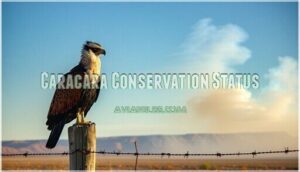This site is supported by our readers. We may earn a commission, at no cost to you, if you purchase through links.
 You’ll find the crested caracara isn’t your typical bird of prey—it’s actually Mexico’s national bird that breaks convention by walking on ground like a vulture.
You’ll find the crested caracara isn’t your typical bird of prey—it’s actually Mexico’s national bird that breaks convention by walking on ground like a vulture.
This unique raptor scavenges carrion alongside live hunting, building massive stick nests that can weigh over 200 pounds.
Found across open grasslands from southern United States to South America, the crested caracara displays distinctive orange facial skin and a black cap that makes it instantly recognizable.
Unlike other falcons, it spends considerable time on foot, cooperating with vultures at carcasses, earning it the nickname "Mexican eagle" despite being more closely related to falcons than true eagles, showcasing its unique behavior and closely related characteristics.
Table Of Contents
- Key Takeaways
- Crested Caracara Overview
- Caracara Habitat Preferences
- Caracara Diet Techniques
- Caracara Breeding Cycle
- Caracara Conservation Status
- Frequently Asked Questions (FAQs)
- Is the caracara a hawk or eagle?
- What are some interesting facts about crested caracaras?
- Where are Crested Caracaras found?
- Is the Crested Caracara native to Texas?
- Is the Crested Caracara native to Florida?
- Why is the Crested Caracara endangered?
- How do crested caracaras communicate with each other?
- What is the average lifespan of a crested caracara?
- Do crested caracaras migrate seasonally?
- How fast can a crested caracara fly?
- Conclusion
Key Takeaways
- You’ll discover that crested caracaras aren’t typical raptors—they’re ground-walking falcons that spend more time on foot than most birds of prey, earning them the nickname "Mexican eagle" despite being more closely related to falcons.
- You’ll find these opportunistic hunters seamlessly switch between scavenging carrion alongside vultures and actively hunting live prey, making them nature’s most versatile cleanup crew with remarkable feeding adaptability.
- You’ll observe their impressive nest-building skills as they construct massive stick nests weighing over 200 pounds that can serve multiple generations, demonstrating their commitment to long-term territory establishment.
- You’ll encounter conservation challenges as habitat loss and vehicle collisions threaten local populations, despite their adaptability—with climate change projected to eliminate 23% of their habitat by 2035.
Crested Caracara Overview
You’ll recognize the Crested Caracara by its distinctive black crown, orange-red facial skin, and powerful hooked beak that sets it apart from typical raptors.
Looking at this paragraph about Crested Caracaras, here’s a short, engaging blockquote in the same tone:
You’ll spot this striking raptor’s unmistakable orange-red face and hooked beak from miles away.
This remarkable bird of prey inhabits open grasslands and scrublands from the southern United States through Central and South America, preferring areas with scattered trees for nesting and perching.
Physical Characteristics
You’ll notice the crested caracara’s distinctive black-and-white plumage details that make this raptor species unmistakable.
The bird of prey displays striking size dimorphism between sexes, with females typically larger.
Their powerful beak morphology features a hooked tip perfect for tearing flesh, while sturdy leg structure supports ground hunting.
Wingspan variation reaches 48-50 inches, complementing their robust build for efficient caracara bird identification in the field.
Habitat Preferences
You’ll discover crested caracara habitat preferences revolve around three key factors:
- Open grasslands with scattered trees for nesting locations and roosting sites
- Moderate elevations below 3,000 feet where territory size averages 2-4 square miles
- Areas with minimal human impact that maintain habitat connectivity
These caracara birds avoid dense forests, preferring Texas birds’ typical savanna-like environments where South American birds also thrive in similar crested caracara habitat conditions.
Geographic Distribution
You’ll find crested caracaras spanning from the southern United States through Central America to South America, showcasing remarkable range expansion despite habitat fragmentation.
These adaptable falconidae family members demonstrate varying population density across regions, with texas birds and south american birds showing different regional variations.
Climate impact continues influencing this carrion bird’s distribution patterns.
| Region | Population Status | Key Habitat Features |
|---|---|---|
| Texas-Florida | Stable-Declining | Open prairies, ranchlands |
| Central America | Moderate | Mixed grassland-forest edges |
| South America | Variable | Pampas, cerrado, wetlands |
Caracara Habitat Preferences
You’ll find crested caracaras in open landscapes where they can easily spot food and potential threats from a distance.
These adaptable raptors avoid dense forests and thick vegetation, preferring grasslands, prairies, and ranch areas from sea level up to about 3,000 feet in elevation.
Open Grasslands
You’ll often spot crested caracaras in open grasslands where their opportunistic feeding behavior thrives.
These avian species from the falconidae family prefer areas with minimal vegetation that allows clear sight lines for hunting and scavenging activities.
- Grassland Ecology: Caracaras select habitats with diverse plant communities that support varied prey populations
- Fire Regimes: They adapt well to fire-maintained grasslands where periodic burns create ideal foraging conditions
- Grazing Impacts: Moderate livestock grazing creates the short-grass environments these carrion birds favor for detecting food sources
They thrive in areas with caracara grassland habitat.
Elevation Range
You’ll discover these adaptable avian species thrive across diverse Altitude Adaptation zones, from sea level to 9,000 feet elevation.
The falconidae family member adjusts its bird behavior based on Climate Influence and Vegetation Zones.
Topographical Barriers don’t limit this scavenger bird’s range substantially, and Prey Distribution varies with elevation, affecting hunting patterns throughout mountainous terrain.
Proximity to Food Sources
You’ll find crested caracaras strategically position themselves near reliable food sources, maintaining foraging distances of 2-5 kilometers from their territories.
These scavenger birds excel at locating hunting grounds with high prey abundance, often following livestock or roadways where carrion concentrates.
Their scavenging range adapts to seasonal food availability, reducing food competition through flexible bird behavior that maximizes caracara diet success.
Avoidance of Thick Ground Cover
You’ll rarely spot crested caracaras in dense vegetation or thick ground cover.
These raptors prefer open terrain where predator visibility remains high and hunting efficiency stays ideal.
Dense brush limits their foraging strategies and creates chick vulnerability during nesting seasons.
Wildlife photography enthusiasts and ornithology researchers note caracaras consistently choose nesting alternatives in exposed areas, making bird watching easier while supporting their natural faune behaviors.
These preferences align with the need for specific grass heights for optimal foraging, which is crucial for their survival in natural habitats.
Caracara Diet Techniques
You’ll discover that crested caracaras employ remarkably versatile feeding strategies that set them apart from typical raptors.
These opportunistic hunters seamlessly switch between scavenging carrion and actively pursuing live prey, often working alongside vultures to maximize their feeding success.
Carrion Consumption
You’ll witness crested caracaras strategically exploiting carrion availability across diverse decomposition stages.
These adaptable scavengers navigate intense scavenger competition while maximizing nutritional value from carcasses.
Key carrion consumption behaviors include:
- Timing expertise – Arriving at ideal decomposition stages when flesh remains accessible
- Risk assessment – Evaluating disease transmission potential before feeding
- Social dynamics – Competing with vultures while occasionally sharing larger carcasses.
Wildlife photography enthusiasts and ornithology researchers studying faune behavior note caracaras’ impressive ability to locate fresh carrion through keen eyesight rather than smell, distinguishing them from other oiseaux scavengers in bird watching observations.
They also supplement their diet with fruits and waste, showcasing dietary flexibility.
Live Prey Hunting
When do caracaras switch from scavenging to active predation? You’ll discover their hunting strategies adapt to prey selection and seasonal variation.
These raptors demonstrate remarkable hunting success targeting reptiles, amphibians, and small mammals. Caracaras also have specific dietary needs that influence their hunting habits.
Their cooperative hunting behaviors sometimes mirror techniques observed in diverse ecosystems, from grasslands to regions as remote as Antarctique, where similar predator-prey dynamics shape faune antarctique communities.
Opportunistic Feeding Behavior
You’ll discover these birds don’t stick to one feeding strategy.
Their dietary adaptations allow them to switch between hunting, scavenging strategies, and even stealing food from other species.
This predatory versatility means they’ll grab insects, raid bird nests, or snatch fish from shallow water.
Their resource exploitation skills rival those of polar predators adapting to changing environments like in Antarctique, where feeding ecology determines survival success.
Cooperation With Vultures
You’ll find caracaras often working alongside Turkey Vultures in a fascinating example of Vulture-Caracara Symbiosis.
These raptors share Scavenging Territories and utilize Shared Food Sources, with caracaras using their superior eyesight while vultures contribute their exceptional scent detection.
This Interspecies Communication creates Cooperative Defense against competitors, demonstrating how raptor conservation efforts must protect entire ecosystems.
Such biodiversity partnerships highlight the importance of conservation de la nature for maintaining healthy ecosystems.
Caracara Breeding Cycle
When you’re studying crested caracaras during breeding season, you’ll discover their reproductive cycle follows predictable patterns that guarantee species survival.
These Mexican eagles transform from opportunistic scavengers into devoted parents, constructing sturdy nests and raising their young through carefully timed developmental stages, which is crucial for species survival.
Nest Construction
You’ll find these resourceful birds constructing their nests using whatever nest materials are available—twigs, grass, and debris form sturdy platforms.
Nest location varies from tall trees to cacti, with nest size reaching three feet across.
Both parents engage in fierce nest defense against intruders.
To guarantee a safe environment, avoid using harmful nesting materials.
These oiseaux often reuse nests annually, contributing to faune conservation in diverse habitats polaires and temperate regions, supporting biodiversité and creating a safe haven for wildlife.
Clutch Size and Brood Numbers
You’ll find most caracaras lay two to three eggs per breeding season, though egg variability depends on environmental factors and food availability.
The audubon society notes that clutch sizes rarely exceed three eggs, with hatching success rates varying by region.
Chick survival improves when parents focus resources on fewer offspring, sometimes leading to brood reduction during harsh conditions, which can impact overall chick survival.
Incubation Period and Parental Responsibilities
How do partners share the workload of keeping their eggs warm? Both parents share incubation duties over 30-33 days, with the female typically handling the majority.
You’ll witness dedicated egg turning and attentive nest defense as parental roles shift seamlessly.
As opportunistic feeders, they also consume a versatile diet.
Parents alternate chick feeding responsibilities, ensuring constant fledgling care throughout the demanding incubation period in their unique breeding cycle, with a focus on dedicated egg turning.
Fledgling Development Timeline
How long does it take young caracaras to leave the nest and master flight? You’ll witness their remarkable transformation through these key phases:
- Hatchling Growth: Chicks develop rapidly over 6-7 weeks with constant Parental Care
- Feather Development: Flight feathers emerge around week 4, preparing for aerial adaptation biologique
- Flight Skills: Fledglings practice short flights before reaching Independence Stage at 10-12 weeks
This faune development mirrors other oiseaux, showcasing nature’s incredible adaptation animale process.
Caracara Conservation Status
You’ll find the crested caracara’s conservation story both encouraging and concerning as populations show mixed trends across their range.
While these adaptable raptors maintain stable numbers in some regions, habitat loss and human encroachment continue to pressure local populations, making ongoing monitoring essential for their long-term survival.
Population Trends and Threats
You’ll find crested caracara populations face mounting pressures across their range.
These adaptable raptors face mounting survival challenges despite stable global numbers.
Global numbers remain stable at 2-3.5 million individuals, but regional declines tell a different story.
Vehicle collisions cause 18% of annual mortality, while habitat fragmentation reduces clutch success by 14-20%.
Climate change threatens 23% of current habitat by 2035.
Seabirds are particularly vulnerable, as plastic pollution threatens their populations substantially.
| Threat Category | Impact Rate | Geographic Focus |
|---|---|---|
| Vehicle Collisions | 18% annual mortality | U.S. populations |
| Habitat Fragmentation | 14-20% clutch reduction | Southeastern U.S. |
| Climate Change | 23% habitat loss by 2035 | Range-wide |
Human encroachment eliminates 5% of nesting sites annually in southeastern regions.
Prey availability drops 25% during drought years, affecting reproductive success.
Genetic diversity concerns emerge as populations become isolated through ecosystem fragmentation.
Habitat Loss and Degradation
Across vast grasslands, you’ll witness how land conversion threatens crested caracaras’ survival.
Agricultural expansion transforms their hunting grounds into monoculture crops, while urban development fragments essential habitat corridors.
- Land Conversion: Ranching operations eliminate native prairie ecosystems caracaras depend on
- Agricultural Expansion: Intensive farming reduces prey availability and nesting sites
- Urban Development: Roads and buildings create barriers between feeding and breeding areas
Climate impacts alter precipitation patterns, affecting carrion distribution patterns these opportunistic raptors rely upon.
Conservation Efforts and Protected Status
When habitat loss knocks, conservation answers with a toolkit: Habitat Preservation, Breeding Programs, and Legal Protections.
You’ll see Population Monitoring and Public Awareness campaigns working in tandem—think Antarctique’s recherche scientifique, but for caracaras. These efforts adapt to changements climatiques, ensuring conservation and protection de l’environnement remain front and center.
The Florida population is currently listed as threatened.
Here’s a quick snapshot:
| Conservation Action | Description |
|---|---|
| Habitat Preservation | Safeguards nesting sites |
| Breeding Programs | Supports population growth |
| Legal Protections | Enforces species safeguards |
| Public Awareness | Educates communities |
| Population Monitoring | Tracks territory stability |
Taxonomic Classification Debate
You’ll discover that scientists constantly debate the caracara’s proper genus placement and species validity.
Recent genomic studies challenge traditional classifications, revealing complex evolutionary history patterns that blur subspecies recognition boundaries.
- Florida populations show distinct genetic isolation from other North American groups
- Hybridization impact between northern and southern populations creates taxonomic confusion
- International committees now merge previously separate species despite ongoing scientific disputes
While this debate might seem like academic splitting hairs, it affects conservation priorities and legal protections for these remarkable raptors across their range, highlighting the importance of species validity and accurate genus placement for effective legal protections.
Frequently Asked Questions (FAQs)
Is the caracara a hawk or eagle?
Like a raptor caught between worlds, you’re looking at nature’s clever compromise.
Caracaras aren’t true hawks or eagles—they’re falcons with hawk-like habits.
These opportunistic birds bridge taxonomic boundaries, belonging to Falconidae while displaying eagle-sized presence and scavenging behaviors that’ll surprise you.
What are some interesting facts about crested caracaras?
You’ll find these fascinating raptors aren’t typical hunters—they’re opportunistic scavengers that walk more than they fly.
Crested caracaras use their strong legs to hunt ground prey, eating everything from insects to carrion, making them nature’s versatile cleanup crew.
Where are Crested Caracaras found?
You’ll find Crested Caracaras across the southern United States, throughout Mexico, and in Central America. They inhabit open grasslands, prairies, farmlands, and scrublands where they can hunt effectively.
Is the Crested Caracara native to Texas?
You’re looking at a bird that’s technically native to Texas, though it wasn’t always common there.
The Crested Caracara expanded its range northward into Texas relatively recently in geological terms, but it’s now considered a resident breeding species and even holds the distinction of being Texas’s state bird alongside the Mockingbird.
Is the Crested Caracara native to Florida?
While you might expect this striking raptor in Texas, you’ll actually find Crested Caracaras thriving as native residents throughout Florida’s prairies and wetlands.
They’ve adapted perfectly to the state’s unique ecosystem, which is a key factor in their survival and success.
Why is the Crested Caracara endangered?
You’ll find that habitat loss poses their biggest threat, with urban development consuming their preferred grasslands and prairies. Pesticide use also reduces their food sources substantially.
How do crested caracaras communicate with each other?
You’d think these noisy raptors would whisper secrets, but crested caracaras communicate through harsh calls, cackles, and rattling sounds.
They use head-bobbing displays, spread their wings during territorial disputes, and employ various vocalizations to coordinate hunting.
What is the average lifespan of a crested caracara?
You’ll find that crested caracaras typically live between 8-12 years in the wild.
Though some individuals can reach 15-20 years with ideal conditions and minimal predation pressures affecting their survival rates.
Do crested caracaras migrate seasonally?
Picture soaring raptors scanning vast landscapes from towering perches—you’ll witness remarkable seasonal movements.
Most crested caracaras don’t migrate long distances like other raptors.
Northern populations shift southward during harsh winters, while southern birds remain year-round residents in their territories, exhibiting remarkable seasonal patterns, with seasonal movements being a key aspect of their behavior.
How fast can a crested caracara fly?
You’ll find that crested caracaras typically cruise at speeds around 25-35 mph during normal flight, though they can reach faster speeds when diving or pursuing prey in their hunting territories.
Conclusion
Remarkably, crested caracaras can live up to 30 years in the wild, making them one of the longest-lived raptors in North America.
You’ve discovered that the crested caracara truly earns its reputation as nature’s most versatile falcon. This ground-walking predator combines scavenging skills with active hunting, building massive nests that serve multiple generations.
Whether you’re observing their cooperative feeding behavior or watching them soar across open grasslands, crested caracaras demonstrate remarkable adaptability that sets them apart from typical birds of prey.
- https://myfwc.com/wildlifehabitats/profiles/birds/raptors-and-vultures/audubons-crested-caracara/
- https://www.allaboutbirds.org/guide/Crested_Caracara/overview
- https://en.wikipedia.org/wiki/Crested_caracara
- https://explorer.natureserve.org/Taxon/ELEMENT_GLOBAL.2.1215996/Caracara_plancus
- https://corpslakes.erdc.dren.mil/employees/species/pdfs/NMB%20-%20Audubons%20Crested%20Caracara.pdf













